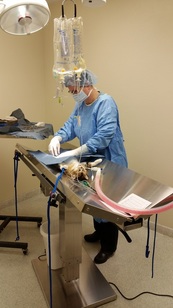What type of surgeries does Crookston Pet Clinic offer?
Surgery questions you should ask- and why
1. Will my pet receive a complete phsysical exam before surgery?
Patients that suffer from parasite infestations, infectious disease or a heart murmur are at increased risk during anesthesia and surgery. A pre surgical exam helps to detect these conditions. Age-appropriate blood work also reveals problems that aren't obvious on a phsyical exam.
2. What safety precautions will you take during surgery?
While most surgeries are uneventful, emergencies sometimes occur. Detecting problems early improves are ability to intervene and correct them. At our clinic we place a breathing tube in anesthetized animals to keep the airway open and administer oxygen and gas anesthetic as needed. While the doctor is concentrating on surgery, our certified veterinary technician monitors vital signs throughout the entire procedure.
A heart (ECG), blood pressure, oxygen, and carbon dioxide monitor is available to track heart rhythm, as well as the amount of oxygen and CO2 in the blood to ensure respiration and circulation are normal. In addition, patients receive IV fluids during surgery to support circulation and we use a heated surgery table to help maintain their core temperature.
Emergency drugs and supplies are nearby. All medications and responses are documented in the patient's medical record and available for future anesthetic plans. Surgery is performed in a sterile environment and antibiotics are not administered to healthy animals undergoing elective spaying or neutering.
While most surgeries are uneventful, emergencies sometimes occur. Detecting problems early improves are ability to intervene and correct them. At our clinic we place a breathing tube in anesthetized animals to keep the airway open and administer oxygen and gas anesthetic as needed. While the doctor is concentrating on surgery, our certified veterinary technician monitors vital signs throughout the entire procedure.
A heart (ECG), blood pressure, oxygen, and carbon dioxide monitor is available to track heart rhythm, as well as the amount of oxygen and CO2 in the blood to ensure respiration and circulation are normal. In addition, patients receive IV fluids during surgery to support circulation and we use a heated surgery table to help maintain their core temperature.
Emergency drugs and supplies are nearby. All medications and responses are documented in the patient's medical record and available for future anesthetic plans. Surgery is performed in a sterile environment and antibiotics are not administered to healthy animals undergoing elective spaying or neutering.
3. What other safety precautions will you take during and after surgery?
Patients lose heat while under anesthesia and when body cavities are open. If a patient gets too cold, the heart can be affected. Our surgery table is heated to minimize this heat loss. We monitor patient temperatures at regular intervals.
Supplemental heat is provided after surgery as needed. Patients are supervised until it is safe to remove the breathing tube and they are well on their way to recovery from anesthesia.
Patients lose heat while under anesthesia and when body cavities are open. If a patient gets too cold, the heart can be affected. Our surgery table is heated to minimize this heat loss. We monitor patient temperatures at regular intervals.
Supplemental heat is provided after surgery as needed. Patients are supervised until it is safe to remove the breathing tube and they are well on their way to recovery from anesthesia.
4. How will you manage my pet's pain?
Surgery hurts! Paint control is the best when it begins before the pain does. All patients receive a pre-anesthetic pain medication. Anesthesia does not provide pain control once the pet wakes up. Patients are given a second pain medication after surgery as well as a laser therapy treatment to the incision area. The laser therapy reduces pain and inflammation while also initiating the healing process.
It is not humane for a pet to lie trembling or immobile after surgery bcause they are in pain. Our patients are up and walking and eating within 2-3 hours of surgery because their pain is controlled. We also offer pain medication for at home.
Surgery hurts! Paint control is the best when it begins before the pain does. All patients receive a pre-anesthetic pain medication. Anesthesia does not provide pain control once the pet wakes up. Patients are given a second pain medication after surgery as well as a laser therapy treatment to the incision area. The laser therapy reduces pain and inflammation while also initiating the healing process.
It is not humane for a pet to lie trembling or immobile after surgery bcause they are in pain. Our patients are up and walking and eating within 2-3 hours of surgery because their pain is controlled. We also offer pain medication for at home.
|
For more information on pain control, download our handout to the right or visit our forms page.
|
| ||
